PLEASE CONTINUE HERE
ESSAY ONE. PART 2
COVERS THE YEARS 1957 – TO 1967
FUNNY FACE TO REFLECTIONS IN A GOLDEN EYE
ONE of the movies listed won Best Picture, while THREE MORE were nominated IN THIS CATEGORY
35. Funny Face (1957)
A+
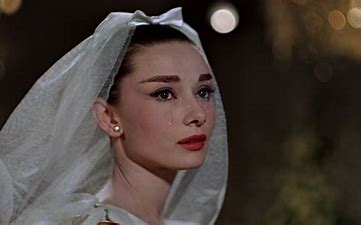
Stanley Donen
(APPROVED)
LGBTQ+ CHARACTER
*Maggie Prescot (Kay Thompson)
LGBTQ+ PRODUCER | ACTOR | SCREENWRITER | SONGWRITERS | CHOREOGRAPHER |COSTUME DESIGNER | PHOTOGRAPHER
PRODUCER: Roger Edens
ACTOR: Fred Astaire
SCREENWRITER: Leonard Gershe
SONGWRITER (COMPOSER): Roger Edens
SONGWRITER (LYRICIST): Leonard Gershe
Choreographer: Eugene Loring
COSTUME DESIGNER: Edith Head
PHOTOGRAPHER: Richard Avedon
AUDREY’S MOST BEAUTIFUL PERFORMANCE
“Funny Face,” the 1957 musical romantic comedy directed by Stanley Donen, boasts Audrey Hepburn’s most charming screen performance. Looking fabulous in black during the movie’s first half, she plays a lowly book clerk in a Greenwich Village store who is “discovered” by Fred Astaire’s Avedon-inspired photographer Fred Avery and whisked off to Paris for Fashion Week—all the photographs in the movie are by Richard Avedon.
Writer Leonard Gershe and producer Roger Edens were one of Hollywood’s A-lister gay couples during the 1950s and ’60s. However, Gershe always maintained that he did not have enough closet space (literally and figuratively) during the relationship.
George and Ira Gershwin’s assorted songs include “How Long Has This Been Going On?” and “S’Wonderful.”
Audrey does all her singing and has a lovely voice, which should also have been heard in “My Fair Lady.”
The movie was responsible for establishing Audrey’s relationship with her favorite fashion designer, Hubert de Givenchy.
The film’s two big musical numbers, both written by Edens (Music) and Gershe (Lyrics), are “Think Pink,” in which Kay Thompson’s Maggie Prescott, the lesbian doyenne of the New York fashion world, unveils her vision for the year ahead (immortal line: “think pink…..bury the beige!”) and, “Bonjour, Paris,” in which Audrey, Fred and Kay, individually, and in concert, celebrate their arrival in Paris (immortal line: Gershe manages to rhyme the Montmartre with Jean-Paul Sartre)
NOW STREAMING ON AMAZON PRIME VIDEO, APPLE TV+, YOUTUBE
36. A Touch of Evil (1958)
A
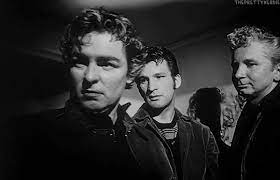
Orson Welles
(APPROVED)
LGBTQ+ CHARACTER
*Mexican gang leader (Mercedes McCambridge)
LGBTQ+ COSTUME DESIGNER
Bill Thomas
You’re a mess, honey
Tanya (Marlene Dietrich) in “A Touch of Evil”
He was some kind of man
Tanya (Marlene Dietrich) in “A Touch of Evil”
Yes, that is Mercedes McCambridge, the unnamed lesbian gang leader getting her kicks while watching Janet Leigh getting roughed up in her motel room in Orson Welles’ masterwork A Touch of Evil.”
Famous for its miraculous opening tracking shot at the US/Mexican border (lasting over three minutes) to Marlene Dietrich’s famous closing line, this great film noir is the third and final of Welles’s three masterpieces following “Citizen Kane” and “The Magnificent Ambersons.”
With Charleton Heston, Joseph Celleia, Akin Tamiroff, Ray Collins, Zsa Zsa Gabor, Dennis Weaver as the motel night manager and, of course, Welles as larger-than-life crooked policeman Hank Quinlan Joseph Cotton turns up in a bit part as a coroner.
Adapted from the novel by Whit Masterson
NOW STREAMING ON AMAZON PRIME VIDEO, APPLE TV, YOUTUBE
37. Auntie Mame (1958)
C+

Morton DaCosta
(APPROVED)
LGBTQ+ CHARACTER
*Vera Charles (Coral Browne)
LGBTQ+ DIRECTOR | ACTOR | SOURCE MATERIAL |COSTUME DESIGNER
DIRECTOR: Morton DaCosta
ACTRESS: Coral Browne
SOURCE MATERIAL: Patrick Dennis, a pseudonym for Edward Everett Tanner III (based on his novel “Auntie Mame: An Irreverent Escapade”)
COSTUME DESIGNER: Orry-Kelly
I must admit that I am not a huge fan of Rosalind Russell, so I fail to see the glory in her performance as gay writer Patrick Dennis’ beloved Auntie Mame. However, most of my gay friends go into a fugue state at the very mention of her name. Gay director Morton DaCosta ((given name Morton Tecovsky and known to his friends as Tec) directs like he is still in the theatre – he did better in his second and penultimate visit to Hollywood with “The Music Man” four years later. The film is notable for its chic lesbian character, Vera Charles, played by gay actress Coral Browne. We shall meet Ms. Browne again in our next essay.
It was adapted from Patrick Dennis’s 1955 novel Auntie Mame and the play Mame by Jerome Lawrence and Robert Edwin Lee.
NOW STREAMING ON AMAZON PRIME VIDEO, APPLE TV+, YOUTUBE
38. Cat on a Hot Tin Roof (1958)
B+
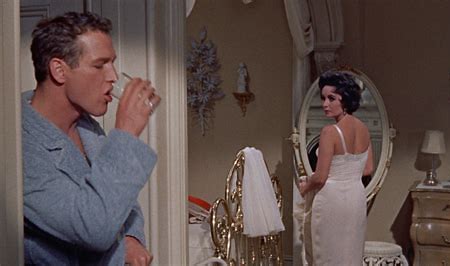
Richard Brooks
(APPROVED)
LGBTQ+ CHARACTER
*Brick Pollitt (Paul Newman)
LGBTQ+ ACTOR | SOURCE MATERIAL
ACTRESS: Judith Anderson
SOURCE MATERIAL: Tennessee Williams (based on his play “Cat on a Hot Tin Roof”)
Written (with James Poe) and directed by Richard Brooks, this respectable adaptation of the Tennessee Williams play opens with gay ex-athlete and football player Brick Pollitt (Paul Newman in his superstar breakthrough) pining and drinking in his bedroom for the memory of his best friend (read lover) and teammate Skipper, who has recently committed suicide. So, who can blame his wife Maggie (“the cat”), beautifully played by Elizabeth Taylor, who ain’t gettin’ any, when she says that she feels like the cat in the movie’s title?
Meanwhile, downstairs, there is a party for Brick’s Daddy – that would be “Big Daddy” – played by Burl Ives in his most memorable movie role. With Judith Anderson as “Big Mamma,” Jack Carson as Brick’s brother, and Madeleine Sherwood as his awful wife and the mother of their five brats.
NOW STREAMING ON AMAZON PRIME VIDEO, APPLE TV+, YOUTUBE
39. Suddenly Last Summer (1959)
C-
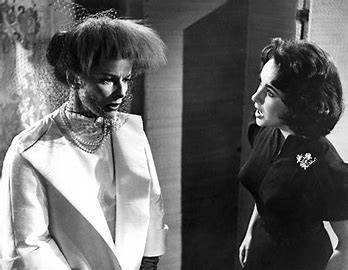
Joseph L. Mankiewicz
(APPROVED)
LGBTQ+ CHARACTER
*Sebastian Venable – we never meet him since he has already been torn to pieces and eaten alive by hordes of young men on a European beach.
LGBTQ+ ACTORS | SCREENWRITERS | SOURCE MATERIAL | PRODUCTION DESIGNER | COSTUME DESIGNER
ACTOR: Montgomery Clift
ACTRESS: Katherine Hepburn
SCREENWRITERS: Gore Vidal and Tennessee Williams
SOURCE MATERIAL: Tennessee Williams (based on his play “Suddenly Last Summer”)
PRODUCTION DESIGNER: Oliver Messel
COSTUME DESIGNER: Oliver Messel
Another Southern Gothic, this time from a less-than-inspired Tennessee Williams play, “Suddenly Last Summer,” was adapted by Gore Vidal and the playwright himself. We never get to meet the film’s central gay character, Sebastian Venable, since he is already deceased; his body was torn to pieces and eaten by hordes of young men on a beach in Europe before the film begins. He was on vacation, accompanied by his cousin Catherine (Elizabeth Taylor). Understandably, since the horrific incident, Catherine has been mentally unstable and prone to relive the details. Katherine Hepburn plays Sebastian’s mother, Violet Venable, who attempts to bribe a young psychosurgeon (Montgomery Clift) to lobotomize Catherine to stop her from talking.
The movie is risible; its few pleasures come from Hepburn’s regal (but very nasty) mother who will do anything to protect her son’s memory, even if that takes turning her niece into a vegetable and for Oliver Messel’s tropical production design complete with venus flytraps. The sore point for Violet is that, when her beauty faded, she was replaced by Catherine – Sebastian used both to attract the boys. Clift, post-accident, looks ill while Taylor does her worst screen work in that awful monologue where she must recall the events of that terrible summer’s day.
NOW STREAMING ON AMAZON PRIME VIDEO, APPLE TV+, YOUTUBE
40. Some Like It Hot (1959)
A+
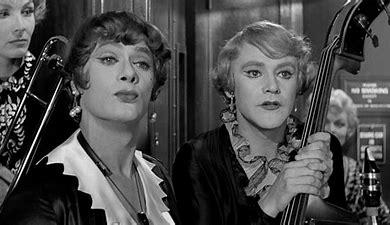
Billy Wilder
(Not Submitted)
LGBTQ+ CHARACTER
*Daphne (Jack Lemmon)
LGBTQ+ COSTUME DESIGNER
Orry-Kelly
MY FAVORITE QUEER COMEDY
Arguably the greatest Hollywood comedy of all time, Billy Wilder’s (with I.A.L. Diamond) classic screenplay was actually adapted from twin sources: The1935 French comedy “Fanfare of Love” courtesy of screenwriters Max Bronnet, Michael Logan, Pierre Prevert, Rene Pujol and Robert Thoerem and its 1951 German remake of the same title credited to Logan, Thoeren and Heinz Pauck. Wilder’s version has a gag every other minute, and the movie blesses us with one of the great comedic performances, Jack Lemon’s Jerry/Daphne. Lemon took his character to a place nobody had dared take one before. Jerry really believes that he is a woman. Even better, he has you believing it! Tremendous work from Tony Curtis and Marilyn Monroe as well. And Joe E. Brown, who delivers the film’s classic closing line.
“Some Like It Hot” was only the second production from a major Hollywood studio (following Otto Preminger’s “The Moon is Blue” in 1953) to be released without first getting the imprimatur of the Hays Office. Wilder thought it didn’t stand a chance. So, he released it unrated, and it became an instant smash! It was the beginning of the end for the Hays code.
Monroe sings a gorgeous version of Gus Kahn’s “I’m Through With Love”
NOW STREAMING ON AMAZON PRIME VIDEO, APPLE TV+, MAX (YOUTUBE)
41. Pillow Talk (1959)
B

Michael Gordon
(APPROVED)
LGBTQ+ CHARACTERS
*“Rex,” the gay Texan, Brad Allen’s alter ego (Rock Hudson)
*Tony Walters (Nick Adams)
*Jonathan Forbes (Tony Randall)
LGBTQ+ ACTORS | COSTUME DESIGNER
ACTOR: Nick Adams
ACTOR: Rock Hudson
COSTUME DESIGNER: Bill Thomas
This was the first of three romantic comedies in which Doris Day, Rock Hudson, and Tony Randall starred together, the other two being “Lover Come Back” (1961) and “Send Me No Flowers” (1964). An enormous success, it was the biggest BO hit of 1959. Hudson plays Brad Allen, a (straight) Broadway composer and playboy who shares a party line with Miss Day’s Jan Morrow, a successful interior decorator (and a virgin) in late1950s New York City. He’s always on the phone, talking to his latest conquests, while she cannot make a single call. Of course, it’s love when they meet, although not strictly at first sight.
To seduce Miss Day’s Jan, Hudson’s Brad invents a gay alter ego, a Texan named “Rex.” “Rex” then mercilessly teases Jan by showing an interest in effeminate things, thereby implying “Rex’s” homosexuality.
So, we have a gay actor playing a straight man pretending to be gay.
Gay actor Nick Adams, who died at 36 in 1968, is the butt of most of the homophobic humor in the Oscar-winning original screenplay, which is credited to Russell Rouse, Maurice Richlin, Stanley Shapiro, and Clarence Greene.
As Rock Hudson’s buddy/rival in all three Day/Hudson pairings, Tony Randall is constantly brushing up against same-sex innuendo.
NOW STREAMING ON AMAZON PRIME VIDEO, APPLE TV+, YOUTUBE
42. Ben Hur (1959)
B
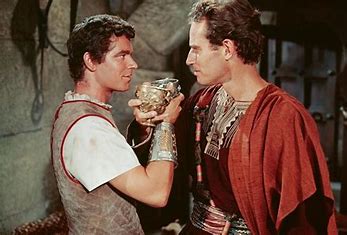
William Wyler
(APPROVED)
LGBTQ+ CHARACTER
*Judah Ben-Hur (Charlton Heston)
*Messala (Stephen Boyd)
LGBTQ+ SCREENWRITERS
SCREENWRITER (UNCREDITED): Christopher Fry
SCREENWRITER (UNCREDITED): Gore Vidal
I persuaded the producer, Sam Zimbalist (this was an MGM film and the writer worked not with the director but the producer; later the director, in this case William Wyler, weighed in) that the only way one could justify several hours of hatred between two lads–and all those horses–was to establish, without saying so in words, an affair between them as boys; then, when reunited at picture’s start, the Roman, played by Stephen Boyd, wants to pick up where they left off and the Jew, Heston, spurns him.
Counterpunch: Gore Vidal responds to Charlton Heston. Los Angeles Times, June 17. 1996.
A THIRD GAY (MALE) COUPLE DECEIVES THE HAYS OFFICE
It’s the big one! William Wyler’s religious epic “Ben Hur” starring Charlton Heston and Stephen Boyd as best friends who have a falling out and then must battle it out in a spectacular fashion – although some would argue that the chariot race in the 1925 Fred Niblo/Ramon Navarro silent version is superior – to Miklos Rozsa’s pounding score. If you believe Vidal, it was all because of a lover’s spat. Wyler and Boyd were in on the ruse, and Boyd played his scenes that way, but Heston was not.
The fact that two gay writers, Vidal and Christopher Fry, gave Karl Tunberg’s script its final polish (both went uncredited, with Tunberg getting sole authorship) and that Fry was at Wyler’s side through most of the filming process at Cinecitta Studios in Rome lends some credence to Vidal’s quote. But, more importantly, you feel that there is more here than just a bromance. If Wyler hadn’t yelled CUT, Heston and Boyd would have become very intimate indeed!
The final irony: of its 12 Oscar nominations, only Tunberg came away empty-handed. The Best Adapted Screenplay Award for 1959 went to Neil Paterson for adapting John Braine’s “Room at the Top.”
Adapted from the novel by Lew Wallace.
NOW STREAMING ON AMAZON PRIME VIDEO, APPLE TV+, YOUTUBE
43. The Dark at the Top of the Stairs (1960)
A-
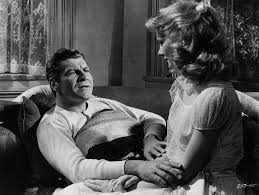
Delbert Mann
(APPROVED)
LGBTQ+ CHARACTER
*Sonny Flood (Robert Eyer)
LGBTQ+ SOURCE MATERIAL
William Inge (adapted from his play “The Dark at the Top of the Stairs”)
Robert Eyer has a few lovely moments as Sonny Flood, the little gay boy who can’t wait to show his uncle Morris (Frank Overton) his picture book of silent movie stars in gay playwright William Inge’s play “The Dark at the Top of the Stairs.” This beautiful adaptation, directed by Delbert Mann in his interim period between Paddy Chayefsky’s slice-of-life realism and Doris Day’s comedy-romance, from a great script by Harriet Frank Jr. and Irving Ravetch, boasts superb performances by Robert Preston as his dad Rubin, Dorothy McGuire as his mom Cora, Shirley Knight as his sister Reenie, Eve Arden as his aunt Lotte and, above all, Angela Lansbury as Mavis Pruitt, the owner of the local beauty salon who has always loved Rubin.
“The Dark at the Top of the Stairs” is unavailable for streaming. However, the DVD can be purchased at Amazon.
44. Spartacus (1960)
B
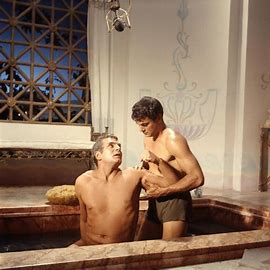
Stanley Kubrick
(APPROVED)
A SCENE INVOLVING General Marcus Licinius Crassus (Laurence Olivier) and his slave Antoninus (Tony Curtis) was initially cut from THE 1960 version. However, it WAS saved from THE CUTTING ROOM FLOOR WHEN THE slave revolt epic was restored in 1991.
LGBTQ+ CHARACTER
*Marcus Licinius Crassus (Laurence Olivier)
LGBTQ+ ACTOR | COSTUME DESIGNER
ACTOR: Laurence Olivier
COSTUME DESIGNER: Bill Thomas
With special mention to Amy Heckerling’s “Clueless.“
Christian had a thing for Tony Curtis, so he brought over “Some Like it Hot” and “Spartacus”
Cher (Alicia Silverstone) in “Clueless”
Poor Cher. She finds out that her dreamboat Christian is gay through his excellent taste in film.
He is particularly taken with the justly famous “Oysters and Snails” from “Spartacus” where General Crassus (Laurence Olivier) gently informs his boyish new slave Antoninus (played by Curtis), a singer of songs, that he likes both and will, therefore, will be vigorously screwing him for the duration of his “employment.” As Crassus exits his bath, this news is enough to make Antoninus run for the hills and join the growing ranks of Spartacus’ army.
And taste is not the same as appetite and, therefore, not a question of morals
Crassus (LAURENCE OLIVIER)to his boy slave Antoninus (tONY cURTIS), a singer of songs, in “Spartacus”
At this very moment, Cher also decides to strike a sexy pose. However, she miscalculates and falls off the bed. Christian, the cinema aesthete that he is, barely notices!
I don’t get it. did my hair get flat? Did I stumble into some bad lighting? What’s wrong with me?
Cher (Alicia Silverstone) in “Clueless”
“Spartacus” was adapted by the formerly blacklisted screenwriter Dalton Trumbo from Howard Fast’s novel.
NOW STREAMING ON AMAZON PRIME VIDEO, APPLE TV+, YOUTUBE
45. Psycho (1960)
A+

Alfred Hitchcock
(APPROVED)
LGBTQ+ CHARACTER
*Norman Bates (Anthony Perkins)
GAY ACTOR
ACTOR: Anthony Perkins
PSYCHO IS ONE OF HITCHCOCK’S SEVEN PERFECT FILMS.
IN THE FINAL SCENE, HITCHCOCK HAS PERKINS BREAK THE FORTH WALL.
Anthony Perkins’ Norman Bates made him immortal while, at the same time, ending his career in Hollywood. With this fearless performance, he had crossed a line, and there was no way back.
During a Friday afternoon affair in a Phoenix hotel, real estate secretary Marion Crane (Janet Leigh) and her boyfriend Sam Loomis (John Gavin) discuss their inability to get married because of Sam’s debts. Marion returns to work, steals $40,000, and drives to Sam’s home in Fairvale, California. She stops for the night at the Bates Motel, located off the main highway during a heavy rainstorm, and hides the stolen money inside a newspaper. Proprietor Norman Bates (Anthony Perkins) descends from a large house overlooking the motel, registers Marion under an alias, and invites her to dine with him. After Norman returns to his house, Marion overhears him arguing with his mother about his wish to dine with Marion. Marion decides to drive back to Phoenix in the morning to return the stolen money. As she showers, a shadowy figure appears and stabs her to death. Norman cleans up the murder scene, putting Marion’s body, her belongings, and the hidden cash in her car, and sinks it in a swamp.
Hitchcock used a small crew, assembled from his TV series Alfred Hitchcock Presents, to film the movie. The most notable change was cinematographer John L. Russell replacing Hitchcock regular John Burks for the film’s striking black-and-white lensing. However, Hitchcock regulars George Tomasini, Bernard Herrmann, and Saul Bass remained in post-production. Their contributions to the editing, score, and title sequence are all essential to the film’s success.
Never was Hitchcock’s ability to manipulate an audience’s sympathies more evident than in the “car in the pond” scene. Within just a few minutes of her horrific death, we have forgotten about Janet Leigh. We are now rooting for her killer, Anthony Perkins, and we all breathe a massive sigh of relief when, after a gut-wrenching pause, the car containing Janet’s body finally goes under the water.
Norman may not be gay because of his sexual attraction to Marion. However, he is most assuredly Queer, thus cementing the fifth letter in our LGBTQ acronym. Hitchcock liked to cast Queer actors in Queer parts. A known gay actor who had relationships with several famous male stars of the day, including Rock Hudson and Tab Hunter, Perkins died from complications of AIDS in 1992 after having been married and fathering two children. Norman is a crossdresser who is smothered by an overbearing mother and displays traits associated with traditional “feminine” behavior, hinting that Norman is repressing his genuine desire for a same-sex partner. Oscar-nominated screenplay by Joseph Stefano adapted from the novel by Robert Bloch.
Hitchcock’s cameo: 0:06:59. Seen through an office window wearing a Stetson cowboy hat as Janet Leigh comes through the door
NOW STREAMING ON Amazon Prime Video, Apple TV+ and YouTube
46. Purple Noon (1960)
B+
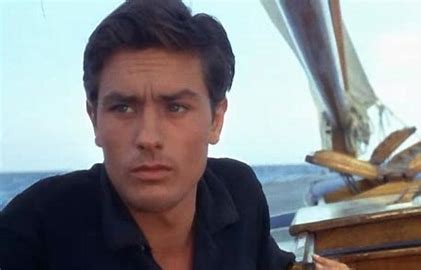
Rene Clement
(APPROVED)
LGBTQ+ CHARACTER
*Tom Ripley (Alain Delon)
LGBTQ+ SOURCE MATERIAL
Patricia Highsmith (based on her novel “The Talented Mr. Ripley”)
The first adaptation of Queer author Patricia Highsmith’s 1955 novel “The Talented Mr. Ripley” covers the same ground as the titular 1999 Anthony Minghella version and the eight-episode limited series on Netflix written and directed by Steve Zaillian and starring Andrew Scott. Gay sociopath Tom Ripley (an almost impossibly beautiful Alain Delon in his movie debut) kills and then assumes the identity of the wealthy and spoiled Dickie Greenlief (Maurice Ronet). Although it lacks the emotional depth and the great supporting cast of Minghella’s film, this version has a unique style thanks to the directorial talents of French two-time Oscar winner Rene Clement (“Forbidden Games”) and his master cinematographer Henri Decae (“The 400 Blows”). Italy has never looked so beautiful. As for Delon, he is sensational. The world had no choice but to sit up and take notice. A superstar is born before our eyes.
NOW STREAMING ON AMAZON PRIME VIDEO, CRITERION COLLECTION(YOUTUBE) AND APPLE TV+
47. Victim (1961)
B+
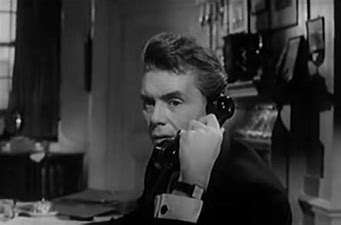
Basil Dearden
Denied due to its frank treatment of homosexuality and released without a seal of approval.
Years later, it received a PG/13 rating from the MPAA
LGBTQ+ CHARACTER
*Melville Farr (Dirk Bogarde)
*Boy Barrett (Peter McEnery)
*PH (Hilton Edwards)
LGBTQ+ ACTORS
ACTOR: Dirk Bogarde
ACTOR: Hilton Edwards
DIRK BOGARDE’S BRAVE PERFORMANCE
Dirk Bogarde plays a successful, happily married (to Sylvia Syms) lawyer who is being blackmailed because of a gay affair in his past with Boy Barrett (Peter McEnery).
This film did more to sway public and political opinion on homosexuality in England than any parliamentary discussion. Six years later, in 1967, homosexuality was decriminalized in Great Britain.
I first saw this film in my early teens. It was on Irish television, and I remember my mom saying how brave Dirk Bogarde was to play a gay character since he was a known gay actor (you cannot say an OUT gay actor since this was not possible in 1961). She was right.
Openly gay Irish actor Hilton Edwards (born in London but immigrated to Ireland in his early twenties) has a small but very memorable scene as a blind patron of a gay bar whom his younger-sighted friend feeds all the gossip. He could be the blackmailer! Edwards and his life partner Micheál Mac Liammóire (né Alfred Wilmore, also in London) founded Dublin’s Gate Theatre, which nurtured such talents as Orson Welles, Geraldine Fitzgerald, and James Mason. When I was growing up, they were Ireland’s “only” homosexual couple. Although fêted by all, their union was always illegal – both actors being long dead before homosexuality was finally decriminalized in Ireland in 1993.
Original screenplay by Janet Green and John McCormick.
NOW STREAMING ON AMAZON PRIME VIDEO, MAX(YOUTUBE),
48. A Taste of Honey (1961)
B+
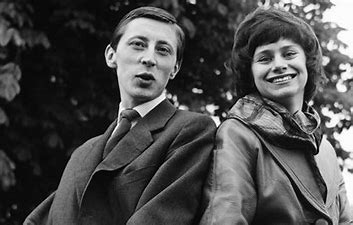
Tony Richardson
(APPROVED)
LGBTQ+ CHARACTER
*Geoffrey Ingham (Murray Melvin)
LGBTQ+ DIRECTOR | ACTOR
DIRECTOR: Tony Richardson
ACTOR: Murray Melvin
QUEER KITCHEN SINK REALISM!
Tony Richardson’s adaptation of the Sheila Delaney play still shines. Delaney wrote the screenplay with Richardson, who directed the original Broadway production of the play in 1960. The film exemplifies a gritty British film genre that has come to be called kitchen sink realism. Rita Tushingham, who embodied the spirit of British Independent Cinema in the early through the mid-sixties, plays seventeen-year-old Jo, who lives in a run-down, post-industrial area of Salford in the British Midlands. One day, Jo meets Jimmy (Paul Danquah), a cook on a boat on the Manchester Ship Canal. After a one-night stayover, Jo discovers that she is pregnant. Wanting to keep the baby but not wanting to marry Jimmy, Jo moves in with her best friend Geoff (Murray Melvin), a gay man who says that he will marry Jo and take care of her and the baby. Although he was playing a teenager, gay actor Murray Melvin was almost thirty when he made “A Taste of Honey.” One of the first openly gay actors, Melvin often worked with Richardson and director Ken Russell. His most memorable movie scene is the card game in Stanley Kubrick’s “Barry Lyndon” with its natural candlelight and Schubert’s Piano Trio in E Flat on the soundtrack.
Dora Bryan is particularly memorable as Tushingham’s self-centered and alcoholic mother.
NOW STREAMING ON AMAZON PRIME VIDEO, APPLE TV+, MAX (YOUTUBE)
49. The Children’s Hour (1961)
C
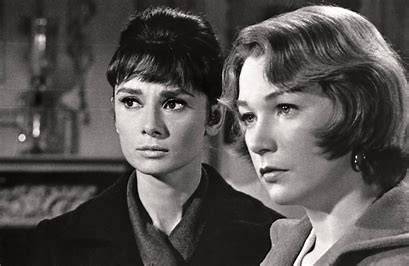
William Wyler
(APPROVED)
LGBTQ+ CHARACTER
*Martha Dobie (Shirley MacLaine)
ITS QUEERNESS RESONATED MUCH MORE EFFECTIVELY WHEN WYLER MADE IT A THINLY DISGUISED HETEROSEXUAL DRAMA IN 1936
When William Wyler and Sam Goldwyn adapted Lillian Hellman’s play “The Children’s Hour” back in 1936, they changed the lesbian story to a straight triangle with Merle Oberon, Miriam Hopkins, and Joel McCrea and a wonderfully nasty Bonita Granville as the little brat who spreads the false rumor. And it worked beautifully. What’s more, the Queer subtext was there. Released as “These Three,” it was a considerable success, paving the way for a whole series of classic movies that Wyler made under the Godwyn banner.
Cut to 1961, fresh from his triumph with “Ben Hur,” Wyler decides to remake it, keeping Hellman’s original same-sex theme. He casts two of the greatest actresses in Hollywood, Audrey Hepburn and Shirley MacLaine, as the school mistresses whose lives and careers are destroyed by a rumor spread by one of their vindictive students. This time, MacLaine plays the gay character Martha, who secretly loves her friend and colleague Karen (Hepburn) but can never reveal her true feelings. Meanwhile, Karen is in a stable heterosexual relationship with Joe (James Garner).
Unfortunately, Wyler was stuck between two periods. 1961 was unprepared for an all-out gay film, so he had to be furtive. Not having the courage of his convictions, what started as bravery ended as cowardice. This time, it’s all text and no subtext! If he had waited another decade he might have had a triumph. There are moments, from MacLaine in particular, but they are not enough. The result is for die-hard Wyler fans only.
Playing the grandmother, whose reaction to her granddaughter’s lie sets the plot in motion, Fay Bainter was nominated for an Oscar for Best Supporting Actress. It was her final screen role.
NOW STREAMING ON AMAZON PRIME VIDEO, APPLE TV+, YOUTUBE
50. Advice and Consent (1962)
A-
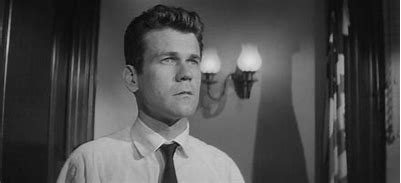
Otto Preminger
(APPROVED)
LGBTQ+ CHARACTER
*Senator Brig Anderson (Don Murray)
LGBTQ+ ACTORS | COSTUME DESIGNER
ACTOR: Charles Laughton
ACTOR: Walter Pidgeon
COSTUME DESIGNER: Bill Blass
THE FIRST LOOK INSIDE AN AMERICAN GAY BAR
Otto Preminger always liked to be innovative, and he was with “Advice and Consent,” a beautifully written, acted, and directed film. It also treats its gay subplot with great tenderness and respect, with the consistently superb (and underrated) Don Murray playing a gay senator who is being blackmailed as a new Secretary of State is going through the Senate Approval process. Preminger also likes to play tricks, and Anderson’s arch nemesis, a reactionary Southern senator, is played by gay actor Charles Laughton in his final film role.
Only those scenes with the lousy George Gizzard prevent “Advise and Consent” from becoming a classic. He gives a master class in awful acting while such luminaries as Henry Fonda, Peter Lawford, Burgess Meredith, Walter Pidgeon, Lew Ayers, and Franchot Tone, in addition to Murray and Laughton, do some of the best work of their illustrious careers.
A minor deduction, too, for having to endure a sadly faded Gene Tierney as a Washington socialite whose sole purpose seems to be the thankless and needless task of explaining, to the ladies-who-lunch (and the viewer), the difference between the House of Representatives and the Senate.
Adapted from the novel by Allen Drury.
NOW STREAMING ON AMAZON PRIME VIDEO, APPLE TV+, YOUTUBE
51. Whatever Happened to Baby Jane? (1962)
A+
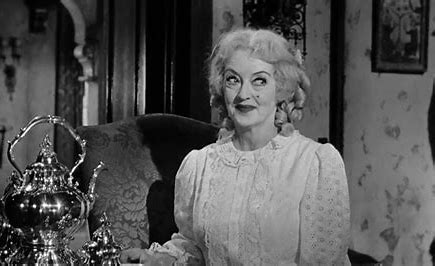
Robert Aldrich
(APPROVED)
LGBTQ+ CHARACTER
*Edwin Flagg (Victor Buono)
LGBTQ+ ACTOR
ACTOR: Victor Buono
DAVIS AND CRAWFORD ARE SPECTACULAR!
Thanks to Lukas Heller’s superb adaptation of the Henry Farrell novel, Robert Aldrich’s masterpiece works as both drama and camp. Both of Hollywood’s grande dames, Bette Davis and Joan Crawford, are in top form, with Davis getting the showier role as faded child star Baby Jane Hudson. However, Miss Crawford also performs superbly as Jane’s sister, Blanche. This former movie queen uses a wheelchair, her career ending abruptly following an automobile accident in the early thirties. She is the eye at the center of Bette’s hurricane. Gay actor Victor Buono is perfection as Bette’s date Edwin Flagg, who sees something he shouldn’t, leading to Davis’s famous pronouncement “He Hate’s Me.” Cheers to Australian actress Marjorie Bennett, who plays his mother, Dehlia Flagg – she is straight out of a John Waters movie. “Baby Jane” is gay sensibility incarnate. Every Davis line is immortal, but some of my favorites are “You mean all this time we could have been friends,” “Because you didn’t eat your din-din,” and “But you are Blanche, you are in that chair!”
The excellent movie score is by Frank De Vol.
NOW STREAMING ON AMAZON PRIME VIDEO, APPLE TV+, YOUTUBE
52. That Touch of Mink (1962)
C+
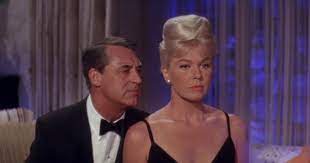
Delbert Mann
(APPROVED)
LGBTQ+ CHARACTER
*Connie (Audrey Meadows)
*Roger (Gig Young)
LGBTQ+ ACTORS
ACTOR: Cary Grant
ACTOR: Richard Deacon (uncredited)
In between the Rock Hudson movies “Pillow Talk” (1959), “Lover Come Back” (1961), and “Send Me No Flowers” (1964), Doris Day paired up with Cary Grant in another movie co-written by Stanley Shapiro. The director is Delbert Mann, a graduate of television and the Paddy Chayefsky school of slice-of-life naturalism (“Marty,” “The Catered Affair,” The Bachelor Party”) who, the previous year with “Lover,” showed a surprising flair for comedy.
When Philip Shayne’s (Grant) Rolls Royce splashes Cathy Timberlake (Miss Day) while she is going to a job interview, we know this love-hate relationship can only end with a wedding ring. Unfortunately, there is minimal chemistry between the stars. This is one of Grant’s few bad performances, and he looks like he wanted to be anywhere other than with Miss Day. Their scenes together on a trip to Bermuda can only be described as creepy.
On the plus side, the film is gorgeously photographed by Russell Metty, there is a fabulous fashion show courtesy of Bergdorf Goodman and ace costume designer Bill Thomas, and Shapiro gives us not just one but two funny gay subplots. The first involves a perpetually soused Gig Young, playing Grant’s financial adviser, Roger, and his psychiatrist, Dr. Gruber (Alan Hewitt). Because he leaves the room as Roger relays some essential information about Cathy, Dr. Gruber thinks Roger is about to embark on an affair with Philip. This leads to the film’s famous final scene involving Roger, a baby carriage, and an astonished Gruber! Gruber is using Roger to get inside tips on the stock market.
However, when he thinks that Roger is gay, he immediately calls his broker to discard the previous purchase because Roger is now of unsound mind.
He also goes back to Vienna for a refresher course.
The second involves Audrey Meadows as Connie, Cathy’s overprotective, man-hating (read closeted lesbian) roommate who works at the automat across the street from Philip and Roger’s office. She doesn’t overdo it, though. It’s a sweet and funny performance.
Although uncredited, gay actor Richard Deacon has a memorable moment as Mr. Miller Connie’s prissy supervisor, a role that he virtually patented in numerous TV series and small movie parts throughout the sixties, seventies, and early eighties.
Original screenplay by Stanley Shapiro and Nate Monaster.
NOW STREAMING ON AMAZON PRIME VIDEO, APPLE TV+, YOUTUBE
53. Billy Budd (1962)
C
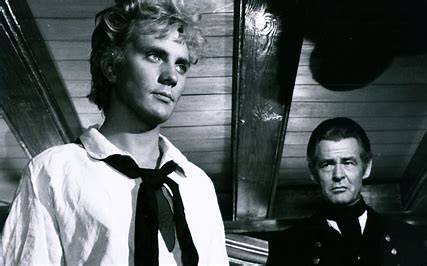
Peter Ustinov
(APPROVED)
LGBTQ+ CHARACTER
*Billy Budd (Terence Stamp)
*John Claggart (Robert Ryan)
*Peter Ustinov (Edward Vere)
LGBTQ+ SOURCE MATERIAL | COSTUME DESIGNER
SOURCE MATERIAL: Herman Melville (based on his novel “Billy Budd Foretopman” )
COSTUME DESIGNER: Anthony Mendleson
Melville’s deep feelings for Nathaniel Hawthorne were immortalized in letters written between the two men from 1850 to 1852.
This historical drama-adventure film was produced, directed, and co-written (with Robert Rossen and DeWitt Bodeen) by Peter Ustinov. from Coxe and Chapman’s stage play of Herman Melville’s short novel and what many consider his second masterpiece after “Moby Dick, “Billy Budd.”
Billy Budd is a “handsome sailor” who strikes and inadvertently kills his false accuser, Master-at-arms John Claggart (Robert Ryan). The ship’s Captain, Edward Vere (Ustinov), recognizes Billy’s lack of intent but claims that the law of mutiny requires him to sentence Billy to be hanged.
Ustinov cast a then-unknown Terence Stamp as beautiful Billy. He became an overnight sensation, causing the otherwise unremarkable film to become hugely profitable. He was nominated for Best Supporting Actor of 1962, losing out to Ed Begley in “Sweet Bird of Youth.” Of course, many, including myself, would argue that Billy is the picture and that the rest of the cast supports him!
Claggart’s jealousy of Billy is never explained, but we presume it is due to Billy’s stunning good looks and unbounded optimism. However, many, including gay composer Benjamin Britton, who wrote his famous opera based on the Melville novel, maintained that there is an undercurrent of homoeroticism between Billy, Claggart, and Vere. A Queer Film, therefore, based on a Queer Novel! Sometimes, I get this from the movie; sometimes, I don’t. As for “Billy Bud the Opera,” not being an opera buff, I have yet to see it!
NOW STREAMING ON AMAZON PRIME VIDEO, APPLE TV+, YOUTUBE
54. Walk on the Wild Side (1962)
C-
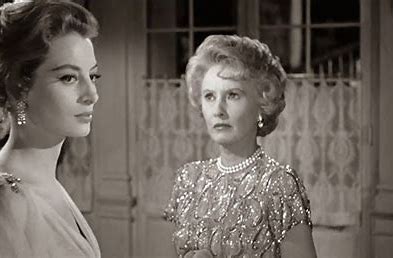
Edward Dmytryk
(APPROVED)
LGBTQ+ CHARACTER
*Hallie (Capucine)
*Jo (Barbra Stanwyck)
LGBTQ+ ACTOR | COSTUME DESIGNER
ACTRESS: Barbara Stanwyck
COSTUME DESIGNER: Charles LeMaire
Laurence Harvey’s Dove Linkhorn and Jane Fonda’s Kitty Twist meet on a road in Texas during the Great Depression and decide to hitchhike together to New Orleans. Dove is searching for his lost love, Hallie (Capucine), and when they arrive in The Big Easy, he finds her working at the Doll House, an upscale French Quarter bordello where Jo (Barbara Stanwyck) is the madam. A lesbian relationship is suggested between Jo and Hallie. However, Hallie, who is unhappy with her lot in life, still works for Jo as a prostitute, but she does not want to give up her comforts and risk married life when Dove proposes.
Stanwyck, looking butch, and Capucine, looking femme, have a few good scenes together. However, Harvey is wan, and Fonda does not have enough to do. It’s no fun. The film also stars Anne Baxter as the owner of a diner where Harvey gets a job, Joanna Moore (mother of Tatum O’Neill), and Juanita Moore (no relation).
Directed by Edward Dmytryk. Music by Elmer Bernstein.
Adapted by John Fante from the 1956 novel A Walk on the Wild Side by Nelson Algren.
NOW SCREENING ON AMAZON PRIME VIDEO
55. The L-Shaped Room (1963)
A-
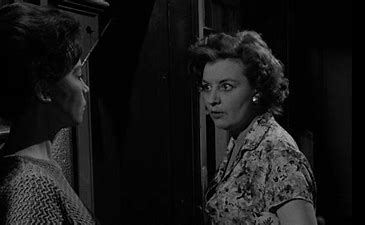
Bryan Forbes
(APPROVED)
LGBTQ+ CHARACTER
*Mavis (Cicely Courtneidge)
*Johnny (Brock Peters)
A recording of the song “Take Me Back to Dear Old Blighty,” sung in the film by Mavis, is sampled at the beginning of the title track of the album “The Queen is Dead” by the Smiths.
Writer/director Bryan Forbes’s lovely and faithful adaptation of the Lynne Reid Banks novel boasts Leslie Caron’s most outstanding performance. She is a young woman who is unmarried and waits out her pregnancy in a strange city where she rents the L-shaped bedroom of the title. Having just appeared in “To Kill a Mockingbird,” Brock Peters plays Johnny, a shy, gay musician. At the same time, Cicely Courtneidge is perfect as her understanding landlady, Mavis, who we gradually realize is not only gay but is in mourning for a lost love.
NOW STREAMING ON YOUTUBE
56. The Haunting (1963)
B+
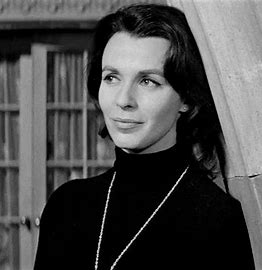
Robert Wise
(APPROVED)
LGBTQ+ CHARACTER
*Theo (Theodora) (Claire Bloom)
“I don’t stay after six. Not after it begins to get dark. I leave before the dark, so there won’t be anyone around if you need help. No one lives any nearer than town. No one will come any nearer than that. In the night! In the dark”!
Mrs. Dudley, the housekeeper (ROSALIE CRUTCHLEY) in “THE HAUNTING”
LESBIAN CHIC COURTESY OF CLAIRE BLOOM
As a chic Greenwich Village lesbian named Theo, whose couture is designed by Mary Quant, Claire Bloom is a knockout in Robert Wise’s 1963 movie “The Haunting.” A clever adaptation of the Shirley Jackson novel, it is one of the best haunted-house movies. Theo is one of a panel of experts in the paranormal who are invited to spend a weekend at the notorious Hill House. The house has a long history of strange and tragic happenings. The locals think that it is haunted. Theo puts the moves on the film’s doomed heroine, Eleanor (“Nell”), played by Julie Harris in her most emblematic screen performance. However, Theo’s moves are always subtle and done with great care and concern, making her one of the cinema’s most enlightened gay characters up to that point in time. Cheers Claire! You always were a class act!
As the caretaker’s wife, Rosalie Crutchley has a great departure scene when bidding Theo and Nell goodbye on their first night in the house; she exits with:
NOW STREAMING ON AMAZON PRIME VIDEO, APPLE TV+, YOUTUBE
57. The Servant (1963)
A
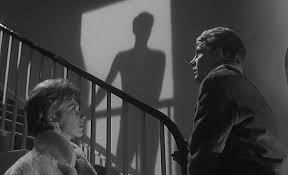
Joseph Losey
(APPROVED)
LGBTQ+ CHARACTER
*Hugo (Dirk Bogarde)
*Tony (James Fox)
LGBTQ+ ACTOR
ACTOR: Dirk Bogarde
Adapted by Harold Pinter from Robin Maugham’s novella and directed by Joseph Losey, “The Servant” has a tenuous current of homoeroticism lurking beneath its master (James Fox) and servant (Dirk Bogarde) power play. Losey and Pinter, however, are more concerned with examining how the waning British class system stood circa 1963, and it’s one of the most chilling films ever made.
Remade by Donald Cammell and Nicolas Roeg as “Performance” in 1970, with Fox playing a variation on his original role and Mick Jagger stepping into Bogarde’s shoes.
Winner of Best Screenplay of 1964 from the NYFCC. The stunning black and white cinematography is by Douglas Slocombe. With Sarah Miles as Bogarde’s “sister” and Wendy Craig as Fox’s girlfriend.
NOW STREAMING ON AMAZON PRIME VIDEO, APPLE TV+, AND BFI CLASSICS.
58. The Leather Boys (1964)
B

Sidney J. Furie
(Not Submitted)
LGBTQ+ CHARACTER
*Pete (Dudley Sutton)
*Reggie (Colin Campbell)
LGBTQ+ COSTUME DESIGNER
COSTUME DESIGN: Harry Haynes
Canadian journeyman Sidney J. Furie, who would come into his own the following year with “The Ipcress File,” does a striking job with this “gay” love story set within the milieu of London’s biker subculture. Working-class teenagers Dot (Rita Tushingham) and biker Reggie (Colin Campbell) get married. Their marriage soon turns sour, and they live increasingly separate lives. Meanwhile, Reggie becomes more involved with his biker friends, especially the somewhat “eccentric” Pete (Dudley Sutton). There is an unfortunate scene in a gay bar towards the end, which leads to an abrupt copout ending. However, the movie’s long closing tracking shot is classic filmmaking.
The Ace Cafe on London’s North Circular Road, the diner/meeting point in the film, was restored and reopened in 2001 after many years of being used as a tire depot.
The Smiths’ “Girlfriend in a Coma” features Tushingham and Campbell on the cover.
“The Leather Boys” influenced Katherine Bigelow’s movie debut, “The Loveless” (1981).
Original screenplay by Gillian Freeman.
NOW STREAMING ON YOUTUBE
59. The Loved One (1965)
A-
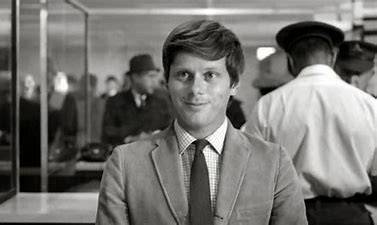
Tony Richardson
(APPROVED)
LGBTQ+ CHARACTER
*Mr. Joyboy (Rod Steiger)
LGBTQ+ | DIRECTOR | ACTORS | SCREENWRITER WRITER |COSTUME DESIGNER
DIRECTOR: Tony Richardson
SCREENWRITER: Christopher Isherwood
ACTOR: John Gielgud
ACTOR: Tab Hunter
ACTOR: Liberace
ACTOR: Roddy McDowell
COSTUME DESIGNER: Rouben Ter-Arutnian
Great fun was had by all adapting Evelyn Waugh’s 1948 short satirical novel about the funeral business in Los Angeles. However, understandably, it was not a hit at the box office and ruined any chance of a Hollywood career for director Tony Richardson. It now has a cult following and is highly regarded in some quarters, including TheBrownees. Haskell Wexler’s black-and-white photography is quite stunning. Christopher Isherwood and Terry Southern wrote a very witty screenplay. The fantastic cast includes:
- Robert Morse as Dennis Barlow
- Anjanette Comer as Aimée Thanatogenos**
- Jonathan Winters as Henery Glenworthy and Wilbur Glenworthy
- Rod Steiger as Mr. Joyboy
- Dana Andrews as Gen. Buck Brinkman
- Milton Berle as Mr. Kenton
- James Coburn, as the Immigration Officer
- Ayllene Gibbons as Mr. Joyboy’s Mother
- John Gielgud as Sir Francis Hinsley
- Tab Hunter, as the Whispering Glades tour guide
- Margaret Leighton as Mrs. Helen Kenton
- Liberace as Mr. Starker
- Roddy McDowall as DJ, Jr.
- Robert Morley as Sir Ambrose Abercrombie
- Alan Napier, as the English Club’s official
- Barbara Nichols as Sadie Blodgett
- Lionel Stander, as the Guru Brahmin
- Paul Williams as Gunther Fry
- Jamie Farr as a waiter at an English Club (uncredited)
** Aimée means BELOVED, and Thanatogenos means BORN OF DEATH.
NOW STREAMING ON AMAZON PRIME VIDEO, APPLE TV+, YOUTUBE
60. Darling (1965)
B
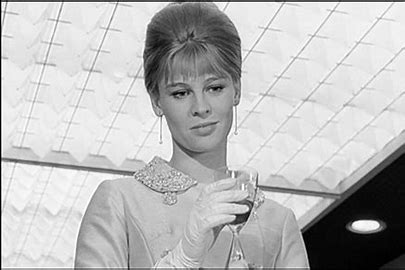
John Schlesinger
(APPROVED)
LGBTQ+ CHARACTER
*Miles Brand (Dirk Bogarde)
LGBTQ+| DIRECTOR | ACTORS
DIRECTOR: John Schlesinger
ACTOR: Dirk Bogarde
ACTOR: Laurence Harvey
It was so fashionable in 1965, so dated today. Never has a film demonstrated how rapidly modishness withers. Still, it features a star-making and Academy Award-winning turn by the impossibly beautiful Julie Christie, even if far more people saw her as Lara in David Lean’s equally lackluster “Doctor Zhivago,” released the same year – she even got a theme of her own. Christie is Diana Scott, a young, successful model in swinging sixties London who plays with the affections of two older men (Dirk Bogarde and Laurence Harvey), one of whom is married (Bogarde).
Bogarde and Harvey were both gay. The latter gained massive advances in his career because of his decade-long relationship with producer James Woolf, who, with his brother John, had founded Romulus/Remus Films in the early 50s and produced Harvey’s star-making performance in “Room at the Top.”
Director John Schlesinger would go on to direct far better Queer Films such as “Midnight Cowboy” and “Sunday Bloody Sunday,” which will be covered in my follow-up essay on Queer Cinema: “Queer Cinema Comes Out (1967 – 1976).”
The Oscar-winning Original Screenplay is by Frederic Raphael.
NOW STREAMING ON AMAZON PRIME VIDEO, BFI CLASSICS (APPLE TV+)
61. My Hustler (1965)
B

Andy Warhol and Chuck Wein
(Not Submitted)
“My Hustler” is the only extant Factory Film that
Has been transferred to digital media.
Has turned a profit.
LGBTQ+ CHARACTER
*Ed – the client (Ed Hood, uncredited)
*Joe – the older hustler (Joe Campbell, uncredited)
*Paul – the younger hustler (Paul America, uncredited)
LGBTQ+ PRODUCER |DIRECTOR | CINEMATOGRAPHER
Andy Warhol
LGBTQ+ DIRECTOR
Chuck Wein
LGBRQ+ ACTORS
Ed Hood (uncredited)
Paul America (uncredited)
Joe Campbell (uncredited)
Prepare to be surprised. If the only Andy Warhol films you have seen are “Chelsea Girls” and “Empire State,” don’t give up. “My Hustler” is a hugely different film with a solid narrative and surprisingly good performances. Warhol codirects with Chuck Wein, a hugely positive influence and at around 70 minutes, it’s quite a joy to sit through. This is mainly due to the marvelous lead performance of an uncredited Ed Hood, who manages to create a hilarious yet sympathetic character out of what could have been just another bitchy “old” queen. I have lots of straight friends who like this movie.
Warhol and Wein originally conceived the film. Much of the dialogue was improvised, and there is no screenwriting credit. Paul Morrissey acted as the (uncredited) camera operator, with Warhol credited as cinematographer.
NOW AVAILABLE TO STREAM ON THE INTERNET ARCHIVE (ARCHIVE.ORG)
62. Persona (1966)
A+
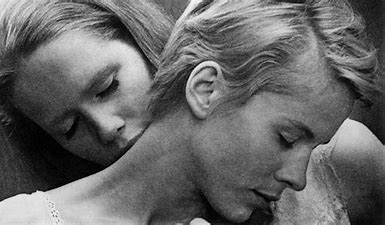
Ingmar Bergman
Approved with two scenes edited out. These have since been restored.
LGBTQ+ CHARACTER
*Alma (Bibi Andersson)
*Elisabet (Liv Ullmann)
My favorite film THAT IS not in the English language.
TWO OF THE GREATEST PERFORMANCES IN MOVIE HISTORY
One of the Jungian archetypes, the persona – as formulated by Swiss psychiatrist and psychoanalyst Carl Jung – enables an individual to interact with the surrounding environment by reflecting on the role in life that the individual is playing. In that way, one can arrive at a compromise between one’s innate psychological constitution and society.
Ingmar Bergman’s “Persona” is a cinematic masterpiece that examines the complex and intimate relationship between two women, Elisabet (played by Liv Ullmann) and Alma (played by Bibi Andersson). Elisabet, a theatre actress, suddenly becomes mute during a performance of “Electra,” and Alma, a nurse, is assigned to care for her. They move to a cottage on Fårö (aka “Bergman”) island off the coast of Sweden, where, in their isolation, the women develop a deep emotional bond that blurs the lines between reality and imagination. Elizabet’s silence and withdrawal contrast with Alma’s volubility and desire for emotional connection. Eventually, Alma begins having trouble distinguishing herself from her patient.
Bergman’s revolutionary script and direction delve into such topics as vampirism, motherhood, abortion, and the Jungian theory of persona, all the while highlighting that this is fundamentally a love story between two women. Andersson’s and Ullman’s performances rank among the greatest in movie history.
In addition, the movie gives us not just one but two supremely erotic moments. The first is Andersson’s now famous monologue in which Alma recounts an episode from her youth where she and her friend Katarina engaged in a spontaneous orgy on a beach. The sensuality of the moment is centered on Alma’s memory of the intimate connection between herself and her friend as their legs were touching while being penetrated by unknown men who had been watching them as they sunbathed. The second is a series of intimate compositions of the two women, which were filmed in black-and-white in extreme close-ups by the legendary Swedish cinematographer Sven Nykvist. These images have become iconic
Original screenplay by Ingmar Bergman
NOW STREAMING ON AMAZON PRIME VIDEO, APPLE TV+, MAX (YOUTUBE)
63. The Group (1966)
C
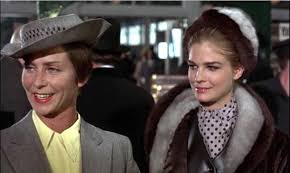
Sidney Lumet
(APPROVED)
LGBTQ+ CHARACTER
*Lakey (Candice Bergen)
*The Baroness, Lakey’s “friend” from Europe (Lidia Prochnicka)
Based on the 1963 novel of the same name by Mary McCarthy about the lives of eight female graduates (played by Joanna Petit, Jessica Walter, Mary Robin Redd, Candice Bergen, Shirley Knight, Joan Hackett, Kathleen Widdoes, and Elizabeth Hartman) from Vassar from 1933 to 1940, director Sidney Lumet’s movie is like a microcosm of his career – biting off more than he can chew. The film meanders incessantly, with only Joan Hackett’s Dottie (at the beginning), Elizabeth Hartman’s Priss (in the middle), and Shirley Knight’s Polly (at the end) getting the respect they deserve. The other five actresses and their characters get no respect or insight whatsoever. It’s a lost opportunity. This goes double for Candice Bergen, making her movie debut as the film’s token lesbian character, Lakey. Lakey spends most of the movie in Europe, a place where rich lesbians were banished in movies like this before there was a “California.”
At the outbreak of WW2, Lakey returns to the United States with a Baroness in tow. However, said Baroness (Lidia Prochnicka) gets no dialogue. Her sole purpose is to be introduced to The Group at the railway station so we can see the shock on their faces; her queerness is not subtle! So, unlike Lauren Bacall and Katherine Kurasch in “Young Man With a Horn” or Sandy Dennis and Anne Heywood in “The Fox, “ no relationship is documented here. Probably just as well since, even though Bergen’s natural beauty is striking, she is so tightly coutured in a series of stiff “lesbian outfits” by designer Anna Hill Johnstone that it’s a wonder the poor thing could even breathe. In some of her scenes, I swear she looks like a prototype for the Corleone brothers in “The Godfather,” for which Johnstone would design her landmark costumes six years later.
NOW STREAMING ON AMAZON PRIME VIDEO, APPLE TV +, MAX (YOUTUBE)
64. Valley of the Dolls (1967)
Rated C (Solo)
High Camp at a Midnight Screening
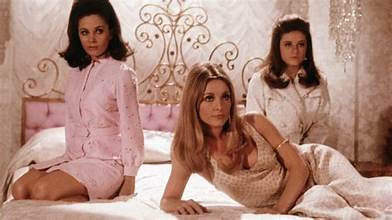
Mark Robson
(APPROVED)
LGBTQ+ CHARACTER
*Ted Casablanca (Alexander Davion) is a hairdresser who is often assumed to be gay by others, but his actual sexual orientation is unknown.
LGBTQ+ COSTUME DESIGNER
William Travilla
Based on Jacqueline Susann’s trashy but compulsively readable novel about three women (Patty Duke, Barbara Parkins, and Sharon Tate) trying to forge careers in the entertainment industry, each descending into barbiturate addiction – the valley of the “dolls.” TCF quickly realized that they had a real turkey on their hands, but the film, coasting on the book’s popularity, was a huge hit. Over time, Fox also realized that, thanks to Miss Patty Duke’s Neely O’Hara and, to a lesser degree, the terrible performance of Susan Hayward as fading star Helen Lawson, they also were the proud owners of a gay kitsch cult classic. A movie to be seen at A MIDNIGHT SCREENING WITH A GAY CROWD, PREFERABLY AT THE CASTRO THEATRE IN SAN FRANCISCO – in other words, it’s a Rocky Horror GROUP experience. It should never be seen alone, or you will be feasting on “dolls” yourself. Duke is so bad in this movie because she thinks she is giving a shoo-in Oscar-caliber performance. Amid all the campness, Parkins and a surprisingly moving Tate survive relatively unscathed.
Andre and Dory Previn wrote the campy yet haunting theme of the film. As sung by Dionne Warwick, it reached #2 on the Hot 100 but was NOT nominated for an Oscar in the Best Original Song category.
The two Best Quotes in the movie are, of course, courtesy of Neely:
I have to get up at five o’clock in the morning and SPARKLE, Neely, SPARKLE!
Neely O’ Hara (PATTY DUKE) in “VALLEY OF THE DOLLS“
Ted Casablanca is not a fag, and I’m the dame to prove it!
Neely O’ Hara (PATTY DUKE) in “VALLEY OF THE DOLLS”
NOW STREAMING ON AMAZON PRIME VIDEO, APPLE TV +, YOUTUBE
65. Reflections in a Golden Eye (1967).
A+
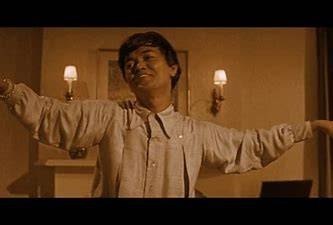
John Huston
(APPROVED)
LGBTQ+ CHARACTER
*Anacleto (Zorro David)
*Major Weldon Penderton (Marlon Brando)
ACTOR | DIRECTOR | WRITER | SOURCE MATERIAL |SONGWRITER | COSTUME AND SET DESIGN |
ACTOR: Marlon Brando
ACTOR: Zorro David
SOURCE MATERIAL: Carson McCullers(based on her novel Reflections in a Golden Eye ).
Director John Huston’s favorite of all his movies. Not for everyone, but if it’s to your taste, spellbinding. Brando does something unique with his closeted gay character, who is married to Elizabeth Taylor. She is having an affair with their best friend, Brian Keith. Keith’s wife, Julie Harris, has just chopped off her nipples with the garden sears in protest. Her only friend and confidant is her flamboyant Filipino houseboy, Anacleto, brilliantly played by gay actor Zorro David. You are correct if you think you have just entered Carson McCullers’ country.
Additional goodies: Actor Robert Forster (“Jackie Brown”), making his film debut, spends almost the entire movie naked while riding Elizabeth Taylor’s horse!
The haunting score is by Toshiro Mayuzumi.
NOW STREAMING ON AMAZON PRIME VIDEO, APPLE TV+, YOUTUBE
PLEASE CONTINUE TO PART ONE
https://thebrownees.net/essay-one-1-34-queer-films-made-under-the-hays-code-1934-1956/
PLEASE CONTINUE TO TABLE
https://thebrownees.net/essay-one-table-65-queer-films-made-under-the-hays-code-1934-1937/
Essay One (1/2). Queer Films Under the Hays Code (1934-1967). – TheBrownees
https://thebrownees.net/essay-one-1-2-65-queer-films-under-the-hays-code-1934-1967/
Essay Two. Table. 50 Queer Films from 1967-1976: Queer Cinema Comes Out. – TheBrownees


















